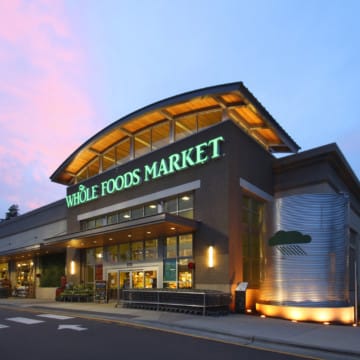Meier & Frank Delivery Depot
On the National Register of Historic Places, the Meier & Frank Delivery Depot now houses the North American headquarters of Vestas, a global energy company specializing in wind power, as well as Gerding Edlen’s headquarters and tech firm Urban Airship. Redeveloped to showcase energy and water efficiency, the building has a very robust stormwater management system. Water is collected from the green roof and captured in a 169,000-gallon concrete cistern, which saves an estimated 193,000 gallons of water per year and provides 100 percent of the water needed for irrigation, cooling tower makeup, and toilet flushing. Filtration planters and bioswales surround the perimeter of the building and filter runoff directly into the ground.
Context
The combined sewer system in Portland strains the area’s watersheds, forcing the city to invest in pipe expansion projects in hopes of protecting its rivers for salmon and other sensitive local species. Renee Loveland, the sustainability manager at Gerding Edlen, explains that “dealing with stormwater has always been a sensitive issue and a priority for the city.” Redevelopment of the historic Meier & Frank depot was an opportunity for the redevelopment team and the building’s tenants to promote green infrastructure and endorse best practices in stormwater management. Construction was completed in 2012, resulting in an extremely high-functioning building and LEED Platinum certification. Although going above LEED Gold standards cost roughly 2 percent of the total construction budget, incentives related to energy and water efficiency, which accrued to the project, resulted in a payback period of only seven and a half years.
Located in the Pearl District of downtown Portland, today’s Meier & Frank depot is a beautiful blend of historic preservation and innovative stormwater management technologies. A top priority was maintaining the integrity of the building’s 1928 facade through the retrofit process. To that end, double-paned, energy efficient replicas of the old single-paned historic windows were commissioned from a local glazing fabricator, and the original penthouse addition on level five was scaled back to comply with historic sightline requirements. Vestas, a renewable energy system producer, manages and occupies most of the building, which is home to its North American headquarters.
Innovative Water Management Features
- Concrete cistern. The 169,000-gallon cistern collects water from the green roof for reuse both outside and within the building. A new floor had to be poured at grade after interior demolition was complete, so using the space below to install a basic concrete cistern was a cost-effective and practical strategy.
- Real-time monitoring. Vestas installed extensive submetering to track equipment performance and follow the building’s consumption patterns. The monitoring system allowed the company to identify at least one contractor error early on, resulting in significant avoided losses compared to identifying the problem from a spike in utility bills.
- Bioswales and urban landscaping. The building comprises a full 200-by-200-foot city block and is surrounded by bioswales on all four sides. These were partially funded by a Green Investment Fund operating through the local Bureau of Environmental Services.
Value Proposition
Gerding Edlen asserts that investment in green infrastructure and the building’s energy-efficient design have added value to the Meier & Frank depot and introduced opportunities for operational cost savings. The real-time monitoring has helped track energy and water consumption patterns for the building, keeping extra costs associated with high resource use to a minimum. Reusing captured water for three major nonpotable uses also lowers operational costs.
The redevelopment of the Meier & Frank depot and the arrival of Vestas also represented a value proposition for Portland. The city sought to attract the tenant and was partially successful because of its offer of the historic Meier & Frank depot as a headquarters building. After making the decision to open its North American headquarters in Portland, Vestas was heavily involved in the redevelopment process, taking a more hands-on role than a typical commercial tenant.
Lessons Learned
- Innovative water management and recycling techniques can be achieved in the context of a historic building. The Meier & Frank Delivery Depot maintains its historic facade and charm while incorporating innovative water management technologies, some of which are invisible to passers-by.
- Stormwater management can be part of a holistic workplace health philosophy. According to Loveland, Vestas “took a European approach to healthy workplaces, which is becoming more and more the type of design approach for highly sustainable buildings in this market.” Along with water management, healthy workplace practices include prioritizing natural light; incorporating visible, enticing staircases; and providing employees with direct views of the outdoors.
- Water reuse strategies need to consider the building occupant. When the building first opened, reused water in the building was treated according to code requirements but was discolored, making users uncomfortable. The building switched to piped water for about a month while the tank was cleaned, which removed residue that had accumulated during construction. Since then, only minor variations in color have occurred and no further complaints have been heard. Building management also markets the green efforts, including signs reading “We flush with rainwater” to raise awareness about this environmental accomplishment at the building.
- The opportunity for a green, resource-efficient building won Portland a high-profile new company. The vision for the Meier & Frank depot, including the water management strategy, ultimately was a successful economic development tool for the city. The water and energy-efficient vision for the Meier & Frank depot paralleled priorities of a high-profile company, becoming a successful economic development tool for the city.


